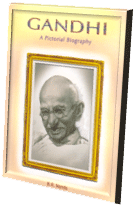
P.O. SEVAGRAM, DIST.WARDHA 442102, MS, INDIA. Phone: 91-7152-284753
FOUNDED BY MAHATMA GANDHI IN 1936
BIOGRAPHY OF GANDHI
GANDHI - A PICTORIAL BIOGRAPHY
by Shri B. R. Nanda

GANDHI
- A PICTORIAL BIOGRAPHY
Shri B. R. Nanda
Table of Contents
- About Gandhi
- Childhood
- Off To England
- Briefless Barrister
- In The 'Dark Continent'
- The Young Politician
- Satyagraha Struggle In South Africa
- The Making Of The Mahatma
- Return To India
- Gandhi's Ashram
- World War I
- Rowlatt Bills
- Nonviolent Non-cooperation
- Arrest And Imprisonment
- Reaction And Recovery
- Declaration Of Complete Independence
- Gandhi-Irwin Pact
- Round Table Conference
- In London
- Resumption Of Struggle
- Campaign Against Untouchability
- A New Deal For The Village
- The New Constitution
- Hindu-Muslim Antagonism
- Nonviolence In A Violent World
- Cripps Mission
- "Quit India"
- Simla Conference
- Cabinet Mission
- Communal Conflagration
- Partition of India
- Mission of Peace
- The End
- Gandhi and Nonviolence
About This Book
This is the first pictorial biography of Gandhi in which the narrative-concise, readable and incisive is illustrated with contemporary photographs and facsimiles of letters, newspaper reports and cartoons, adding up to a fascinating flash-back on the life of Mahatma Gandhi and the struggle for Indian freedom led by him. There is a skilful matching in this book of text and illustrations, of description and analysis and of concrete detail and large perspective. This pictorial biography will revive many memories in those who have lived through the Gandhian era; it should also be of interest to the post-independence generation.
About Author
Shri B. R. Nanda - former Director, Nehru Memorial Museum and Library, New Delhi. His full-scale biography of Mahatma Gandhi has been published in India, Britain and the U.S.A. and translated into French, Spanish, Italian and several other languages
Chapter-32 : The End
However, he was not destined to pick up the threads of his constructive Programme. He had a narrow escape on January 20, 1948, when a bomb exploded in Birla House in New Delhi where he was addressing his prayer meeting. He took no notice of the explosion. Next day he referred to the congratulations which he had received for remaining unruffled after the explosion. He would deserve them, he said, if he fell as a result of such an explosion and yet retained a smile on his face and no malice against the assailant. He described the bomb-thrower as a misguided youth and advised the police not to "molest" him but to convert him with persuasion and affection. "The misguided youth" was Madan Lal, a refugee from West Punjab, who was a member of a gang which had plotted Gandhi's death. These highly-strung Youngman saw Hinduism menaced by Islam from without and by Gandhi from within. Madan Lal having missed his aim, a fellow conspirator from Poona, Nathu Ram Godse, came to Gandhi's prayer meeting on the evening of January 30, whipped out his pistol and fired three shots. Gandhi fell instantly with the words 'He Rama' (Oh! God).